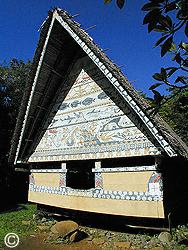 The Bais of Belau
The Bais of Belau
The word Belau, used by Palauans when making reference to Palau, derives from the Palauan word "aidebelau" which translates to "indirect replies." These indirect replies, the legend states, are the replies given to Chuab's questions about the firewood collecting activities (and following stacking of same at her feet) while the plan to destroy her was being carried out.
Rebuilding a Bai
Bai er a Ngesechel a Cherechar, originally built in 1969, was destroyed by fire in 1978. The new bai, which now stands on this site, is a replica of a Bai er a Rubak, built through a combined effort of the Republic of Palau's 3rd National Congress and the Palau Visitors Authority. Construction of the new bai lasted eight (8) months and was completed in March 1991.
Timbers were collected from the hamlets of Meiungs and Ngennid in Koror. Nipa palm leaves from Ngchesar came. at a later date for the roof thatching.
In accordance with tradition, not a single nail, metal screw or peg were used in the assembly of the bai. Lashing was only used to hold and support the roof and its components.
In earlier days, a combination of calculated fire and heavy shell tools were involved in working the huge logs. However, effiency and speed dictated the use
The Bai in the Village
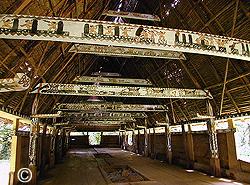 In ancient times, every village in Palau had meeting houses called bai. At the turn of the century, more than one hundred bai existed in Palau. There were several bai sic types, distinguishable by use or form of construction and quality of materials. The Bai er a Rubak (meeting hall for governing elders) is normally located in the village square and also serves as the community center or Bai er Beluu. This type of bai was built of fine hardwoods and elaborately ornamented with traditional designs and colors. Another type of bai was the Bai er a Cbeldebechel (men's club). Normally located at the entrance to each village, it was used by the men's organization in charge of defending the village from adversaries. The construction materials and ornamentation were usually of a lesser quality.
In ancient times, every village in Palau had meeting houses called bai. At the turn of the century, more than one hundred bai existed in Palau. There were several bai sic types, distinguishable by use or form of construction and quality of materials. The Bai er a Rubak (meeting hall for governing elders) is normally located in the village square and also serves as the community center or Bai er Beluu. This type of bai was built of fine hardwoods and elaborately ornamented with traditional designs and colors. Another type of bai was the Bai er a Cbeldebechel (men's club). Normally located at the entrance to each village, it was used by the men's organization in charge of defending the village from adversaries. The construction materials and ornamentation were usually of a lesser quality.
As the most important building in the village, the bai functioned as a meeting house for the governing elders where they were assigned seats along the walls, according to rank and title. There were no dividing walls, no furnishings, and with only two fireplaces to break up the expanse of naturally polished hardwood floor, the great hall was worthy of the dignified group it housed.
Decorations on the Bai
The present bai is typical in its decorative detail. The gables depict the "headline" stories and on the east gable of this bai appears the famous story of MiIadeldid, the goddess, whose children were the four predominant villages of Palau: Koror Aimeliik, Ngeremlengui, and Melekeok. The story tells of her drowning and her being brought back to life by seven spirits in payment for the kindness she previously showed them, Her influence, according to mythology, was far reaching.
On the rear (west gable) is the legend of Chuab. The legend describes how Chuab was blown from heaven to Ngebeanged and grew taller and bigger until she reached the clouds and no one could handle her any longer. How after her demise at the hands of her victims, she fell into the ocean and her body parts sticking out of the water, formed the islands of Belau.
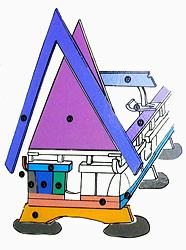 |
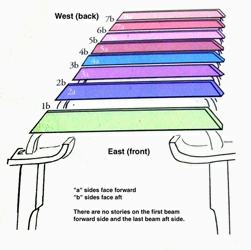 |
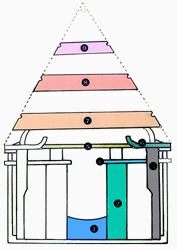 |
| 1. bed (sleeper) 2. uchutem (longitudinal beam) 3. kuoku (transversal beam) 4. saus (cornerpost) 5. kboub (wall) 6. chad (post) 7. uchul a sikes (Sills at gable sides) 8. orsechoki (sills at entrances) 9. ongrangr (longitudinal beam) 10. ongiau (facing) 11. nglikliabed (gable) 12. imuul (first level beams) 13. rekoi (horizontal strut) |
Photographs on the interior 15 foot long/1 foot wide tie beams, represent stories from mythology, folk history and current events, which were chosen by the chiefs and rubaks (titled elders). Each story is complete on the side of the beam, showing comic strip style, six to twenty scenes. The story on the beam 1b being the most important. | 1. iis (treshold) 2. chad (door posts) 3. chellabed (upright posts) 4. orsechoki (sills) 5. olik (crossbeam) 6. rekoi (horizontal strut) 7. imuul/delolakl (first level beams) 8. omkuuk (second level beams) 9. rebereball (third level beams) |
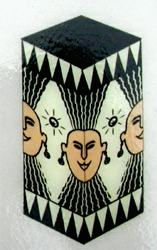
Bellek, the crazy half face spirit, is found inside the bai on some of the support posts. It is a reminder of what can happen, if one is not mindful of the evil spirits lurking about. When someone is not acting according to what is normal that person might be asked "has Bellek gotten into you?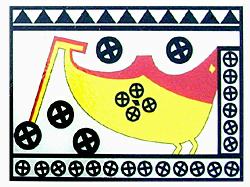
On the four corners of the bai, on the extensions of the window ledges projecting beyond the end walls, are paintings of the money bird (delerrok) holding a piece of Palauan money (circle with cross) at the end of its long beak. It is surrounded by other such pieces and also the gorget type of Palauan money. The gorget still used in ceremonial occasions and worn by women around their neck, was brought from the Philippines as bracelets in the early days and fragmented into the crescent shaped beads to make "change."

 On the underside of the rekoi, which serves as a rack for storing the rolled woven pandan us sleeping mats, one will find a painting of a huge spider. The symbol recalls the story of the famous spider god who taught Palauan women natural childbirth, ending the tradition of cutting open the mothers abdomen to extract the child from the womb.
On the underside of the rekoi, which serves as a rack for storing the rolled woven pandan us sleeping mats, one will find a painting of a huge spider. The symbol recalls the story of the famous spider god who taught Palauan women natural childbirth, ending the tradition of cutting open the mothers abdomen to extract the child from the womb.
Roosters painted on the black background of the exterior post, and common to all bais, represent the famous rooster of the Badrulchau story. Badrulchau, located in northern Babeldoab, is Palau's largest and probably most ancient megalithic site.
When in Palau, be sure to visit the Belau National Museum.
©Belau National Museum & Under Watercolours

